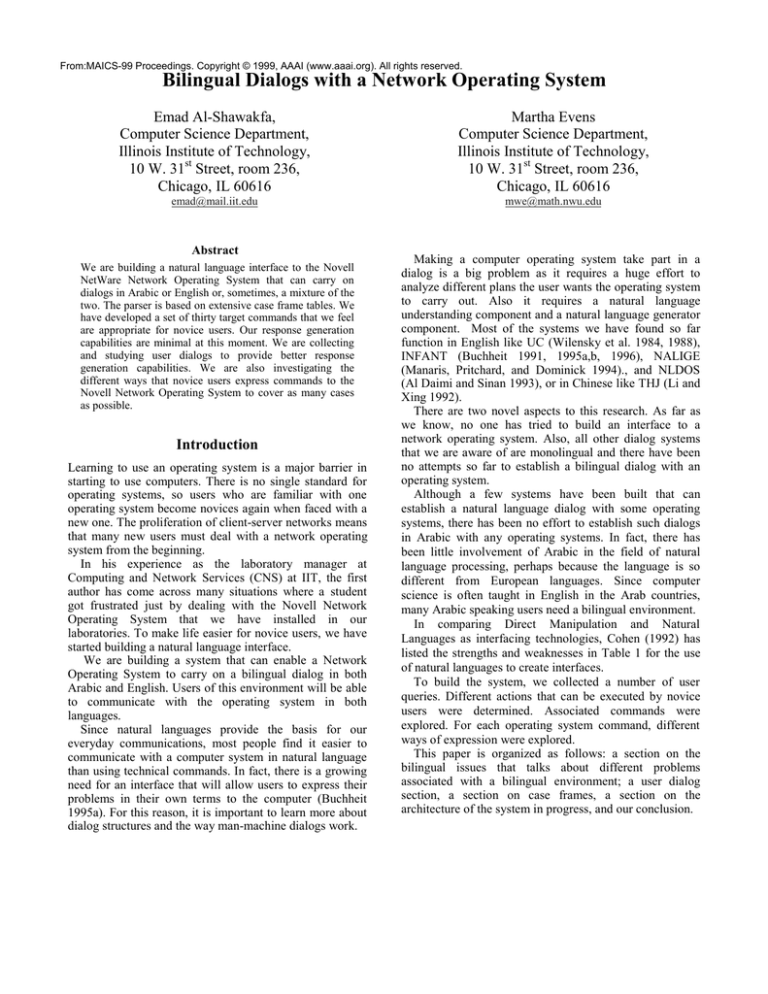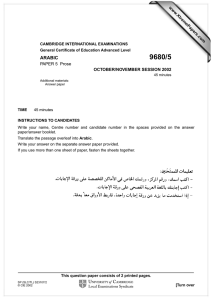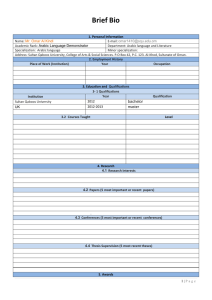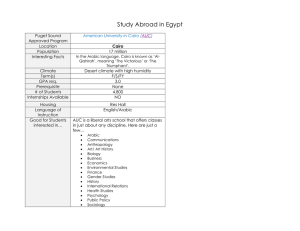
From:MAICS-99 Proceedings. Copyright © 1999, AAAI (www.aaai.org). All rights reserved.
Bilingual Dialogs with a Network Operating System
Emad Al-Shawakfa,
Computer Science Department,
Illinois Institute of Technology,
10 W. 31st Street, room 236,
Chicago, IL 60616
Martha Evens
Computer Science Department,
Illinois Institute of Technology,
10 W. 31st Street, room 236,
Chicago, IL 60616
emad@mail.iit.edu
mwe@math.nwu.edu
Abstract
We are building a natural language interface to the Novell
NetWare Network Operating System that can carry on
dialogs in Arabic or English or, sometimes, a mixture of the
two. The parser is based on extensive case frame tables. We
have developed a set of thirty target commands that we feel
are appropriate for novice users. Our response generation
capabilities are minimal at this moment. We are collecting
and studying user dialogs to provide better response
generation capabilities. We are also investigating the
different ways that novice users express commands to the
Novell Network Operating System to cover as many cases
as possible.
Introduction
Learning to use an operating system is a major barrier in
starting to use computers. There is no single standard for
operating systems, so users who are familiar with one
operating system become novices again when faced with a
new one. The proliferation of client-server networks means
that many new users must deal with a network operating
system from the beginning.
In his experience as the laboratory manager at
Computing and Network Services (CNS) at IIT, the first
author has come across many situations where a student
got frustrated just by dealing with the Novell Network
Operating System that we have installed in our
laboratories. To make life easier for novice users, we have
started building a natural language interface.
We are building a system that can enable a Network
Operating System to carry on a bilingual dialog in both
Arabic and English. Users of this environment will be able
to communicate with the operating system in both
languages.
Since natural languages provide the basis for our
everyday communications, most people find it easier to
communicate with a computer system in natural language
than using technical commands. In fact, there is a growing
need for an interface that will allow users to express their
problems in their own terms to the computer (Buchheit
1995a). For this reason, it is important to learn more about
dialog structures and the way man-machine dialogs work.
Making a computer operating system take part in a
dialog is a big problem as it requires a huge effort to
analyze different plans the user wants the operating system
to carry out. Also it requires a natural language
understanding component and a natural language generator
component. Most of the systems we have found so far
function in English like UC (Wilensky et al. 1984, 1988),
INFANT (Buchheit 1991, 1995a,b, 1996), NALIGE
(Manaris, Pritchard, and Dominick 1994)., and NLDOS
(Al Daimi and Sinan 1993), or in Chinese like THJ (Li and
Xing 1992).
There are two novel aspects to this research. As far as
we know, no one has tried to build an interface to a
network operating system. Also, all other dialog systems
that we are aware of are monolingual and there have been
no attempts so far to establish a bilingual dialog with an
operating system.
Although a few systems have been built that can
establish a natural language dialog with some operating
systems, there has been no effort to establish such dialogs
in Arabic with any operating systems. In fact, there has
been little involvement of Arabic in the field of natural
language processing, perhaps because the language is so
different from European languages. Since computer
science is often taught in English in the Arab countries,
many Arabic speaking users need a bilingual environment.
In comparing Direct Manipulation and Natural
Languages as interfacing technologies, Cohen (1992) has
listed the strengths and weaknesses in Table 1 for the use
of natural languages to create interfaces.
To build the system, we collected a number of user
queries. Different actions that can be executed by novice
users were determined. Associated commands were
explored. For each operating system command, different
ways of expression were explored.
This paper is organized as follows: a section on the
bilingual issues that talks about different problems
associated with a bilingual environment; a user dialog
section, a section on case frames, a section on the
architecture of the system in progress, and our conclusion.
Strengths of natural languages
1. Intuitive
2. Descriptive, including:
a. Quantification.
b. Negation.
c. Temporal Information.
3. Context.
4. Anaphora (e.g. pronouns)
5. Delayed action possible.
Weaknesses of natural languages
1. Coverage is opaque.
2. “Overkill” for short or frequent queries.
3. Difficulty of establishing and navigating
context.
4. Anaphora are problematic.
5. Error prone.
6. Ambiguous.
Table 1: Strengths/Weaknesses of Natural Language Interfaces (Cohen, 1992, p. 145).
Bilingual Issues
Arabic is oriented from right to left while English is
oriented from left to right. If we have a dialog that has
both, then in this case, we are faced with the difficulty of
understanding each utterance. We need to determine how
to deal with such input.
To solve this problem, based on the orientation of the
first word, we are going to consider the language to which
the first word belongs as the host language. At the time any
words written in the second language will be inserted in the
input of the host language. What we mean here is that,
assuming the first word was written in Arabic, then if we
are going to have an English word, then this word will be
inserted in the current line from right to left. In other
words, the first letter will be typed, the second will push
the first to the left, and the third letter will push both letters
to the left and so on until the word is completely typed.
Although it is complicated, mixed orientation is not a
strange thing to the speakers of the Arabic language.
Arabic is oriented from right to left while Arabic numerals
are written and read from left to right.
User Dialogs
During the work done in this research so far, we have
collected two sets of samples of dialog from two different
sources. The first set was obtained at IIT where we have
asked the laboratory staff to write down the different
dialogs they have with the users of the Computing and
Network Services Laboratories in Stuart Building as well
as the Residence Halls. The laboratory staff came back to
us with a set of written questions pertaining to the
interactions of the users with the Novell NOS we have on
our machines.
The second set of language samples was obtained while
the first author was teaching a Novell course at Robert
Morris College to some novice users. In this course, he
gave his students an extra credit homework assignment to
write down a dialog with the Novell operating system. The
homework assignment is shown in Figure 1.
Furthermore, we have obtained a list of Novell
commands that a user might be able to execute in a Novell
Network Operating System environment. Some of these
commands are given in Table 2 with different ways of
saying them. So far, the only language samples that we
have collected are in English. Arabic samples and bilingual
samples need to be collected and analyzed. A scenario of a
possible dialog between the users and the system is given
in Figure 2.
Case Frames
Linguists have known the concept of case for at least 2000
years, but, modern work with case frames originated in the
work of Fillmore (1968). He has introduced six cases and
since then many other cases have been introduced into
research. Cases are often referred to as Thematic Roles or
Semantic Roles or Participant Roles (Wendlandt and
Driscoll 1991). Allen (1995) has refined the cases and
added few more to them. Some of the cases defined by
Allen are: AGENT, CO-AGENT, THEME, COTHEME,
INSTRUMENT,
EXPERIENCER,
BENEFICIARY, AT-POSS, TO-POSS, FROM-POSS,
AT-LOC, TO-LOC, FROM-LOC, AT-VALUE, TOVALUE, FROM-VALUE, AT-TIME, TO-TIME,
FROM-TIME, and PATH
The concept of English Case Frames was used at IIT by
Dardaine (1995) and Pin-Ngern (1990) in the IITLEX
lexicon for the CIRCSIM-Tutor Tutoring System being
implemented at IIT. We have an Arabic lexical database
designed by Al-Khrisat (1992) and Alsamara (1996).
We are using a case frame approach to parsing in our
system for both Arabic and English, furthermore, we are
using the same set of roles for both. An example of an
English Case Frame is given in Figure 3.
CIS 230 LOCAL AREA NETWORKS I.
HOMEWORK FOR AN EXTRA CREDIT
Assuming that the computer in front of you is another person, using your conversational English, what do you think
should be the command issued to the Novell Network Operating System to achieve the following tasks:
1.
2.
3.
4.
5.
6.
7.
8.
9.
10.
11.
12.
13.
Print a file called myfile.txt on the first printer of the Network.
Connect you to a different server on the network called Server2.
Change your password.
Copy a set of files from your home directory to your floppy.
Move some files from the directory Apps to the directory OFFICE.
Protect your files against accidental deletion.
Restore your deleted files.
Make your directory accessible to other users.
Select a printer queue on the Network.
Send a message to a friend on the Network.
Check who is logged on to the Network.
Copy a directory from your account to another account on Server2.
To see what your directory has.
Figure 1: Extra Credit Homework Assignment to Elicit Sample Input.
Case Frames usually hold information about syntax,
semantics and pragmatics related to any verb that will help
us in carrying on the dialog better. For instance, by looking
at the first line in Figure 3, we notice that the verb Print
requires a subject that is an Agent that must be the System.
The second line indicates a Theme as its Direct object that
must be a file, or a list of files. So, one cannot ask to print
the whole directory or the whole disk.
The System.
To enable bilingual interaction with the Novell Network
Operating System, we are implementing a system that will
take the user’s input (either in Arabic or English), analyze
it, extract the semantics from it, and then based on that
representation execute the request. The system has the
following modules:
1) The Tokenizer.
2) Utterance Type Determiner module.
3) The Parser.
- Arabic Grammar.
- English Grammar.
- Arabic Lexicon.
- English Lexicon.
- Arabic Case Frames.
- English Case Frames.
4) The Input Understander.
5) The Command Translator, and
6) The Response Generator and Dialog Planner.
The layout of this system is given in Figure 4.
Two types of knowledge will be kept in the system:
application-nonspecific
(general)
knowledge
and
application-specific knowledge. The general knowledge
will be mainly used to figure out the interaction with the
system and mainly has to do with the natural language
being used during the dialog process, and more
specifically, how sentences can be formed, and how verbs
can be used, etc.
The application-specific knowledge on the other hand,
will be that knowledge that has to do with our application,
in our case the Novell Network Operating System
Commands. The knowledge will be kept in a database of
different commands with all the possible arguments and
options a command may take.
Conclusion
Carrying on dialogs with a computer operating system has
always been a problem for novice users. This inspired us to
try to establish a natural language interface.
Most of the dialog systems we have seen so far function
in English. Furthermore, they are monolingual. Since not
everyone on the face of this planet is fluent with English;
especially in the Arab world, this has encouraged us to
start working on a bilingual dialog that will enable users of
User: Print my file to the first printer.
System: What is the name of your file?
User: test.dat
System: I cannot find test.dat. Do you know where it is?
User: On my floppy.
Figure 2: A Scenario of a Dialog with a User.
Word
Print
e.g.
Syn-Role
Case
Subject
Agent
Obj-Direct
Theme
On-NP
From-LOC
On-NP
At-LOC
From-NP
From-LOC
To-NP
At-LOC
Print file sample.txt on the Printer.
Occurrence
Obligatory
Obligatory
Optional
Optional
Optional
Optional
Sel-Rest
System
file(s)
Storage Media
Printer
Storage Media
Printer
Figure 3: An Example English Case Frame.
Command
Purpose
Revoke
To remove rights from a user
Nprint
Network printing
Setpass
To change the password
Different Ways of saying the command
1. Extract
2. Strip
3. Remove
1. Print
2. Copy
3. Send
1. Change
2. Rename
3. Set password
Table 2: Some Novell Commands with Different Ways of Saying Them.
the Arab world to interact with computer operating systems
in both Arabic and English.
Allen, J. 1995. Natural Language Understanding, Second
Edition. Redwood City, CA: The Benjamin/Cummings
Publishing Company, Inc.
References
Alsamara, K. 1996. An Arabic Lexicon to Support
Information Retrieval, Text Generation, and Parsing. Ph.D.
Dissertation, Computer Science Department, Illinois
Institute of Technology, Chicago, IL.
Al Daimi, K., and Sinan, N. 1993. ‘Communicating with
Operating Systems in Natural Language’. In International
Journal of Intelligent Systems, 8(6):671-684.
Al-Khrisat, M. 1992. Structuring the Arabic Lexicon and
Thesaurus with Lexical-Semantic Relations to Support
Information Retrieval.
Ph.D. Dissertation, Computer
Science Department, Illinois Institute of Technology,
Chicago, IL.
Buchheit, P. 1991. INFANT: A Connectionist Like
Knowledge Base and Natural Language Processing
System. Ph.D. dissertation, University of Illinois at
Chicago.
Buchheit, P. 1995a. A Conversational Interface for File
Management in an Operating System. In Proceedings of
the 1995 Midwest Artificial Intelligence and Cognitive
Science Society Conference, 43-47.
Li, X. and Xing, D. 1992. General Natural Language for
Operating System. SIGART Bulletin, 3(4): 28-32.
Buchheit, P. 1995b. A Natural Language Interface for File
Management in an Operating system. In The 1995 Annual
Meeting of the American Society for Information Science
(SIG/ALP: The Automated Language Processing Special
Interest Group), Chicago, IL.
Manaris, B., Pritchard, J. and Dominick, W. 1994.
Developing a Natural Language Interface for the Unix
Operating System. In SIGCHI Bulletin, 26(2): 34-40.
Buchheit, P. 1996. A General-Purpose Natural Language
Interface to an Operating System. In The International
Journal of Intelligent Systems, 11(7): 409-427.
Cohen, Philip. 1992. ‘The Role of Natural Language in a
Multimodel Interface’. In Proceedings of the Fifth Annual
Symposium on User Interface Software and Technology,
143-149.
Dardaine, J. 1995. Towards the Semiautomatic Generation
of IITROLE: A Case Model Incorporating Syntactic,
Semantic and Pragmatic Information. Ph.D. Dissertation,
Computer Science Department, Illinois Institute of
Technology, Chicago, IL.
Fillmore, C. J. 1968. The Case for Case.. In E. Bach and
Robert Harms (eds.) Uiversals in Linguistic Theory, Holt,
Rinehart, and Winston, New York: 1-88.
Pin-Ngern, S. 1990. A Lexical Database for English to
Support Information Retrieval, Parsing and Text
Generation. Ph.D. Dissertation, Computer Science
Department, Illinois Institute of Technology, Chicago, IL.
Wendlandt, E. and Driscoll, J. 1991. Incorporating a
Semantic Analysis into a Document Retrieval Strategy. In
Proceedings of the Fourteenth Annual International
ACM/SIGIR Conference on Research and Development in
Information Retrieval, 270-279.
Wilensky, R., Chin, D. and Arens, Y. 1984. Talking to
Unix in English: An Overview of UC. Communications of
the ACM, 27: 574-593.
Wilensky, R., Chin, D., Luria, M., Martin, J., Mayfield, J.
and Wu, D. 1988. The Berkeley Unix Consultant Project.
Computational Linguistics, 14 (1): 35-84.
Input Sentence
Tokenizer System
List of
Tokens
Utterance Type
Determiner System
English Grammar
Arabic Grammar
English Cue Words
Lexicon
Arabic Cue Words
Lexicon
English Lexicon
Parser
English Case
Frame Lexicon
Arabic Lexicon
Arabic Case Frame
Lexicon
Input Understander
Command Translator
Novell Command
Lexicon
Response to User
Response Generator and
Dialog Planner.
Figure 4: The Architecture of the Proposed System.






